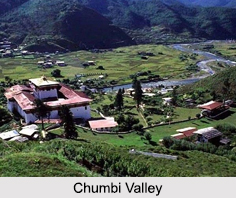 Chumbi Valley is a valley on the south side of the Himalayan drainage divide, near the Chinese border with Sikkim, India and with Bhutan. The Chumbi Valley is connected to Sikkim to the southwest via the mountain passes of Nathu La Pass and Jelep La Pass.
Chumbi Valley is a valley on the south side of the Himalayan drainage divide, near the Chinese border with Sikkim, India and with Bhutan. The Chumbi Valley is connected to Sikkim to the southwest via the mountain passes of Nathu La Pass and Jelep La Pass.
Formerly in Sikkim, Chumbi Valley became part of Tibet in 1792. The inhabitants of the valley are called Promowa and are of Tibetan descent. Extensive trade in wool, yak tails and borax passed through the valley after British negotiations resulted in the establishment of a trade agency at Yadong and a treaty between the British and Tibet in 1904. Since 1951 the valley has been under the control of China, which continued trade with India until 1962, when a 1954 treaty between China and India over the status of Tibet expired, and a border dispute between the two countries erupted.
Location of Chumbi Valley
Chumbi Valley is situated on a small south-pointing protuberance of territory between Bhutan (east) and Sikkim state, India (west). Formed by the passage of the Torsa River, which rises below Tang Pass and flows south into Bhutan, the Chumbi valley has an average elevation of 9,500 feet (2,900 metres), forested slopes, and a pleasant climate most of the year.
Military Expeditions on Chumbi Valley
Being on one of the primary routes between India and Tibet, the Chumbi Valley has been at the forefront of several military expeditions. The Delhi Sultanate`s attempted invasion of Tibet in 1206 and reached the Chumbi Valley. The British military expedition of 1904 occupied the Chumbi Valley for about 3 years after the hostilities to secure Tibetan payment of indemnity. Contemporary documents show that the British continued the occupation of Chumbi Valley until February 8, 1908, after having received payment from China.
This article is a stub. You can enrich by adding more information to it. Send your Write Up to content@indianetzone.com






